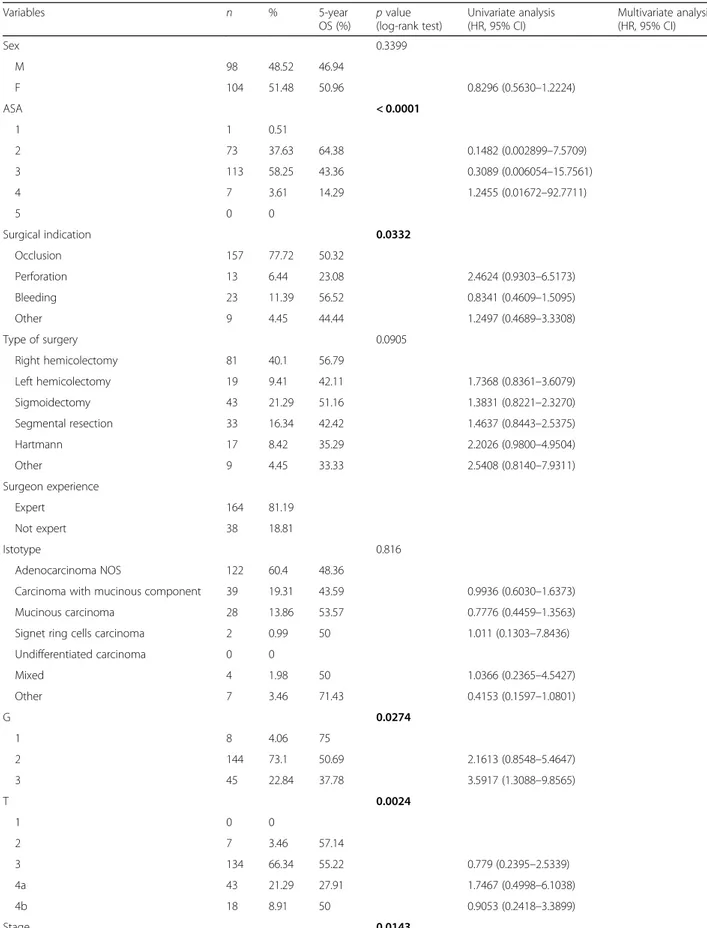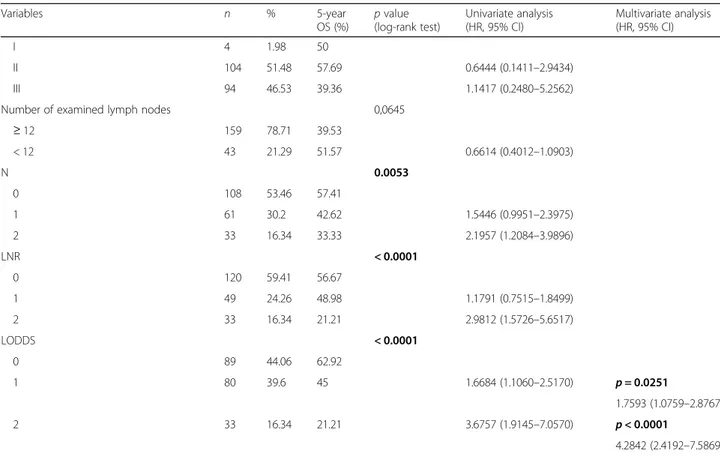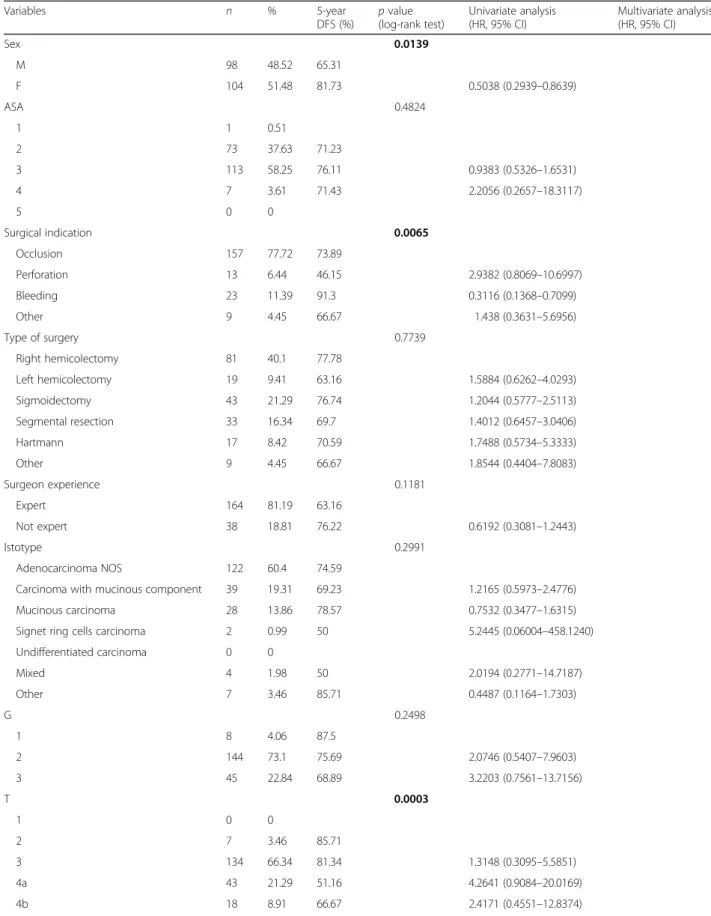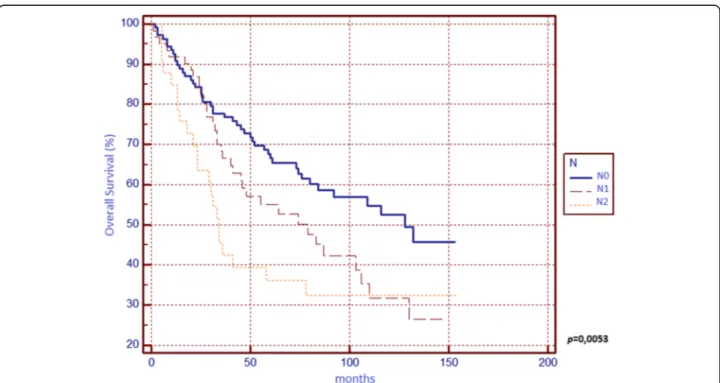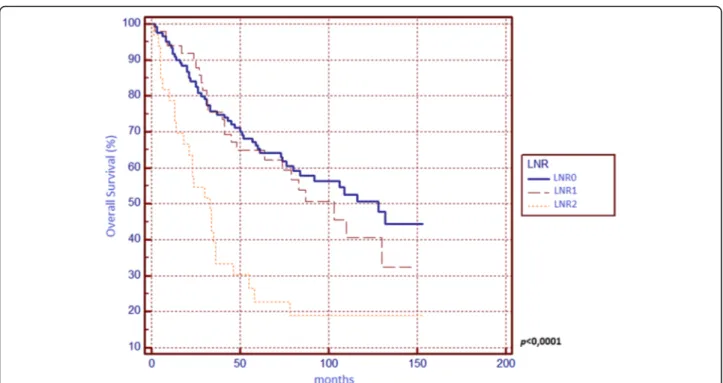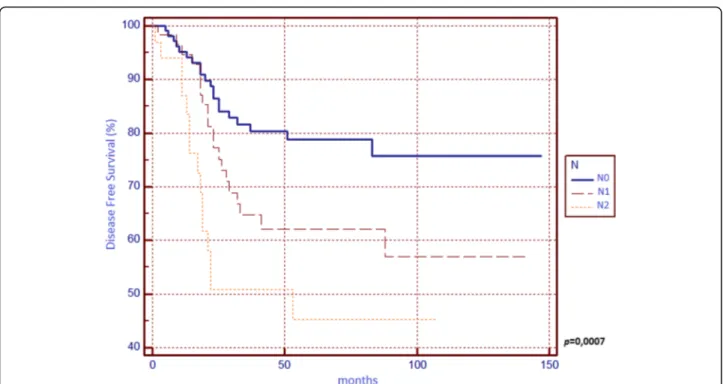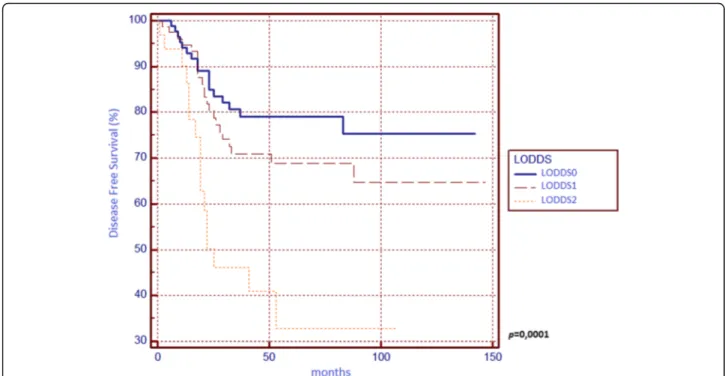R E S E A R C H
Open Access
Evaluation on prognostic efficacy of lymph
nodes ratio (LNR) and log odds of positive
lymph nodes (LODDS) in complicated colon
cancer: the first study in emergency
surgery
Savino Occhionorelli
1, Dario Andreotti
1, Pierpaola Vallese
2, Lucia Morganti
3, Domenico Lacavalla
1, Elena Forini
4and Giovanni Pascale
1*Abstract
Background: Lymph node involvement is one of the most important prognostic factors in colon cancer. Twelve is considered the minimum number of lymph nodes necessary to retain reliable tumour staging, but several factors can potentially influence the lymph node harvesting. Emergent surgery for complicated colon cancer (perforation, occlusion, bleeding) could represent an obstacle to reach the benchmark of 12 nodes with an accurate lymphadenectomy. So, an efficient classification system of lymphatic involvement is crucial to define the prognosis, the indication to adjuvant therapy and the follow-up. This is the first study with the aim to evaluate the efficacy of lymph nodes ratio (LNR) and log odds of positive lymph nodes (LODDS) in the prognostic assessment of patients who undergo to urgent surgery for complicated colonic cancer.
Methods: This is a retrospective study carried out on patients who underwent urgent colonic resection for complicated cancer (occlusion, perforation, bleeding, sepsis). We collected clinical, pathological and follow-up data of 320 patients. Two hundred two patients met the inclusion criteria and were distributed into three grofollow-ups according to parameter N of TNM, LNR and LODDS. Survival analysis was performed by Kaplan-Meier curves, investigating both overall survival (OS) and disease-free survival (DFS).
Results: The median number of harvested lymph nodes was 17. In 78.71% (n = 159) of cases, at least 12 lymph nodes were examined. Regarding OS, significant differences from survival curves emerged for ASA score, surgical indication, tumour grading, T parameter, tumour stage, N parameter, LNR and LODDS. In multivariate analysis, only LODDS was found to be an independent prognostic factor.
Concerning DFS, we found significant differences between survival curves of sex, surgical indication, T parameter, tumour stage, N parameter, LNR and LODDS, but none of these confirmed its prognostic power in multivariate analysis.
Conclusions: We found that N, LNR and LODDS are all related to 5-year OS and DFS with statistical significance, but only LODDS was found to be an independent prognostic factor for OS in multivariate analysis.
Keywords: Colon cancer, Lymph nodes, LODDS, Survival analysis
* Correspondence:[email protected];[email protected]
1Department of Morphology, Surgery and Experimental Medicine, University of Ferrara, via A. Moro, 8, Cona, 44124 Ferrara, Italy
Full list of author information is available at the end of the article
© The Author(s). 2018 Open Access This article is distributed under the terms of the Creative Commons Attribution 4.0 International License (http://creativecommons.org/licenses/by/4.0/), which permits unrestricted use, distribution, and reproduction in any medium, provided you give appropriate credit to the original author(s) and the source, provide a link to the Creative Commons license, and indicate if changes were made. The Creative Commons Public Domain Dedication waiver (http://creativecommons.org/publicdomain/zero/1.0/) applies to the data made available in this article, unless otherwise stated.
Background
Adequate study of lymph nodes status is a fundament of right evaluation of the prognostic outcome for patients who undergo surgery for colonic neoplasm so that the common staging system currently used, the 7th edition of TNM by American Joint Committee on Cancer (AJCC), proposes parameter N for nodal evaluation [1]. In particu-lar, N considers the number of lymph nodes involved by metastatic diffusion of tumoural cells on histological exam-ination, without any mention about the total number of re-trieved nodes.
Twelve is considered the minimum number of lymph nodes necessary to retain reliable tumour staging, but several factors can potentially influence the lymph node harvesting, such as patient and tumour-related factors, but also pathological analysis and surgical technique. For example, lymph node yield is frequently reduced in male, elderly, obese and lower socioeconomic patients, while large and poorly differentiated tumors, longer resection specimens and pre-operative tumour tattooing are asso-ciated with increased lymph node yield [2].
Emergency surgery for complicated colon cancer can represent a trouble for the surgeon, who could come across the necessity to balance the importance of an adequate oncologic resection with the opportunity of a quick control of the septic source and obtaining the hemodynamic stabilization of the patient [3, 4]. This is why emergency surgery can be an obstacle to reach the benchmark of 12 nodes with an accurate lymphadenec-tomy, in addition to all other variables that can influ-ence the nodal harvesting.
In order to improve the accuracy of the nodal study, a new classification of lymphatic involvement has been pro-posed, not only in colorectal cancer.
Lymph nodes ratio (LNR) is defined as the ratio between positive lymph nodes and the total number of retrieved lymph nodes. It has been valued for some types of neoplasms such as the stomach, pancreas, bladder and breast, and some studies found that it is more precise than the parameter N in the prognostic evaluation in colorectal cancer [5,6]. Otherwise, some authors sustain that LNR accuracy is not so reliable when the number of retrieved lymph nodes is low [7]. Furthermore, LNR does not show any advantage over N in case of no lymph node involved in metastatic dif-fusion, since the ratio is evermore 0.
Another classification system has been recently proposed, that is log odds of positive lymph nodes (LODDS), defined as the logarithm of the ratio between the positive and the negative lymph nodes (more 0.5 both to the numerator and to the denominator, to avoid null values). It has been tested in gastric, breast and colorectal cancer [8], and it seems to have a stronger predictive value on survival than N and TNM [9–11].
To our knowledge, none of the published papers about these new classification systems of nodal in-volvement in colorectal cancer has been so far per-formed on a patient who underwent urgent surgery. Our study is the first one carried out on a selected population of patients subjected to urgent surgery for complicated colonic cancer.
Methods
This is a retrospective study performed on patients who underwent urgent colon resection in Arcispedale Sant’Anna of Ferrara for complicated colonic cancer, confirmed by histological examination, between 1 January 2003 and 31 December 2013. Complications included bowel obstruction, perforation and massive bleeding on any other acute condition such as sepsis due to elapsing conditions (for example, appendicitis, diver-ticulitis, suppuration of the neoplastic lump). In case of bowel obstruction, we considered only patients with evident signs of occlusion, leaving outpatients treated with medical therapy or endoscopy“bridge to surgery”.
We collected personal data (age, sex), clinical data (ASA score, surgical indication, time and type of surgery, expertise of the surgeon, tumour localization, clinical stage of neoplasm), pathological data (length of surgical specimen, histology, level of infiltration, grading and lymph nodal status) and data about follow-up (possible re-lapsing, that is loco-regional recurrence or onset of distant metastases, death, overall and disease-free survival).
Exclusion criteria were presence of metastases at diagno-sis (stage IV), presence of neoplastic infiltration on surgical margins or macroscopic residual tumour (not R0 surgery), concomitance of other neoplasms, death into the first post-operative month and insufficient data for analysis.
The patients were distributed according to the current staging system (TNM 7th edition), and nodal status was assessed with histological parameter pN. For each patient, LNR and LODDS were calculated. LNR was defined as the number of positive lymph nodes divided by the num-ber of total examined lymph nodes. LODDS was calcu-lated as log (number of positive nodes + 0.5)/(number of the total examined nodes− positive nodes + 0.5). The patients were stratified in three classes for each parameter, according to the cutoff values reported in previously pub-lished studies [11]: LNR0≤ 0.05, 0.05 < LNR1 ≤ 0.20 and LNR2 > 0.20; − 1.36 ≤ LODDS0, − 1.36 < LODDS1 ≤ 0.53 and LODDS2 > 0.53.
Survival analysis was performed by Kaplan-Meier curves, and the differences between the curves were verified through log-rank test (Mantel-Cox). Cox’s proportional hazard model was used for univariate and multivariate analyses, considering a significant p value < 0.5.
Table 1 OS results
Variables n % 5-year
OS (%) p value(log-rank test)
Univariate analysis (HR, 95% CI) Multivariate analysis (HR, 95% CI) Sex 0.3399 M 98 48.52 46.94 F 104 51.48 50.96 0.8296 (0.5630–1.2224) ASA < 0.0001 1 1 0.51 2 73 37.63 64.38 0.1482 (0.002899–7.5709) 3 113 58.25 43.36 0.3089 (0.006054–15.7561) 4 7 3.61 14.29 1.2455 (0.01672–92.7711) 5 0 0 Surgical indication 0.0332 Occlusion 157 77.72 50.32 Perforation 13 6.44 23.08 2.4624 (0.9303–6.5173) Bleeding 23 11.39 56.52 0.8341 (0.4609–1.5095) Other 9 4.45 44.44 1.2497 (0.4689–3.3308) Type of surgery 0.0905 Right hemicolectomy 81 40.1 56.79 Left hemicolectomy 19 9.41 42.11 1.7368 (0.8361–3.6079) Sigmoidectomy 43 21.29 51.16 1.3831 (0.8221–2.3270) Segmental resection 33 16.34 42.42 1.4637 (0.8443–2.5375) Hartmann 17 8.42 35.29 2.2026 (0.9800–4.9504) Other 9 4.45 33.33 2.5408 (0.8140–7.9311) Surgeon experience Expert 164 81.19 Not expert 38 18.81 Istotype 0.816 Adenocarcinoma NOS 122 60.4 48.36
Carcinoma with mucinous component 39 19.31 43.59 0.9936 (0.6030–1.6373)
Mucinous carcinoma 28 13.86 53.57 0.7776 (0.4459–1.3563)
Signet ring cells carcinoma 2 0.99 50 1.011 (0.1303–7.8436)
Undifferentiated carcinoma 0 0 Mixed 4 1.98 50 1.0366 (0.2365–4.5427) Other 7 3.46 71.43 0.4153 (0.1597–1.0801) G 0.0274 1 8 4.06 75 2 144 73.1 50.69 2.1613 (0.8548–5.4647) 3 45 22.84 37.78 3.5917 (1.3088–9.8565) T 0.0024 1 0 0 2 7 3.46 57.14 3 134 66.34 55.22 0.779 (0.2395–2.5339) 4a 43 21.29 27.91 1.7467 (0.4998–6.1038) 4b 18 8.91 50 0.9053 (0.2418–3.3899) Stage 0.0143
Results
Between 1 January 2003 and 31 December 2013, 320 pa-tients (165 males, 155 females, median age 76 years) underwent urgent colonic resection for complicated colon cancer in our institute. The 70.62% (n = 226) achieved at least 12 lymph nodes harvested, and more than one fourth (29.38%, n = 94) did not obtain an ad-equate study of lymph node status. One hundred eight-een patients were excluded for stage IV (57.63%), non-radical resection (5.08%), presence of other neo-plasms (5.93%), death into the first postoperative month (10.17%) and insufficient data (21.19%).
Therefore, our population was represented by 202 patients (98 males, 104 females, median age 76 years). Most of them were classified as ASA 3 (58.25%) or ASA 2 (37.63%). These patients underwent surgery for bowel obstruction in 77.72% of cases, bleeding in 11.39%, perforation in 6.44% and other indications in 4.45% (seven cases of neoplasm suppuration, one acute appendicitis, one acute cholecystitis), and they were submitted to right hemi-colectomy in 40.1% of case, left hemihemi-colectomy in 9.41%, sigmoidectomy in 21.29%, segmental colonic resection in 16.34%, Hartmann’s colostomy in 8.42% and other surgery in 4.45% (for example, sub-total colectomy). In 26.73% of cases, viscerolysis was associated, in 11.88% prophylactic cholecystectomy, in 4.95% prophylactic appendicectomy, in
3.96% tenual resection and in 1.98% en bloc resection of other abdominal organs. In 81.19% of cases, the interven-tion was performed by an expert colorectal surgeon.
The most frequent neoplasm localization was the left side of the colon, in particular, sigma 29.21%, sigmoid rectal junction 10.4%, left colon 6.93% and splenic flex-ure 5.94%, followed by the right colon with 32.18%, transverse colon 9.41% and hepatic flexure 3.96%. 1.98% the tumour was multifocal.
The mean length of the resected colonic tract was 30.38 cm (range 6–95 cm). The median number of har-vested lymph nodes was 17 (range 3–79). In 78.71% (n = 159) of cases, at least 12 lymph nodes were examined.
The most frequent histologic type was adenocarcinoma NOS (not otherwise specified, 60.4%), followed by carcin-oma with mucinous component (19.31%), mucinous car-cinoma (13.86%), ring cell carcar-cinoma (0.99%), mixed histology (1.98%) and other types (3.46%). In 4.06% of cases, the tumour was well differentiated (G1), in 73.1% moderately differentiated (G2) and in 22.84% poorly dif-ferentiated (G3).
The following were the patients’ distribution for the clin-ical stage: stage I 1.98% (n = 4), stage II 51.48% (n = 104) and stage III 46.53% (n = 94).
Survival analysis was performed by Kaplan-Meier curves, and differences between curves were evaluated
Table 1 OS results (Continued)
Variables n % 5-year
OS (%) p value(log-rank test)
Univariate analysis (HR, 95% CI) Multivariate analysis (HR, 95% CI) I 4 1.98 50 II 104 51.48 57.69 0.6444 (0.1411–2.9434) III 94 46.53 39.36 1.1417 (0.2480–5.2562)
Number of examined lymph nodes 0,0645
≥ 12 159 78.71 39.53 < 12 43 21.29 51.57 0.6614 (0.4012–1.0903) N 0.0053 0 108 53.46 57.41 1 61 30.2 42.62 1.5446 (0.9951–2.3975) 2 33 16.34 33.33 2.1957 (1.2084–3.9896) LNR < 0.0001 0 120 59.41 56.67 1 49 24.26 48.98 1.1791 (0.7515–1.8499) 2 33 16.34 21.21 2.9812 (1.5726–5.6517) LODDS < 0.0001 0 89 44.06 62.92 1 80 39.6 45 1.6684 (1.1060–2.5170) p = 0.0251 1.7593 (1.0759–2.8767) 2 33 16.34 21.21 3.6757 (1.9145–7.0570) p < 0.0001 4.2842 (2.4192–7.5869)
Table 2 DFS results
Variables n % 5-year
DFS (%) p value(log-rank test)
Univariate analysis (HR, 95% CI) Multivariate analysis (HR, 95% CI) Sex 0.0139 M 98 48.52 65.31 F 104 51.48 81.73 0.5038 (0.2939–0.8639) ASA 0.4824 1 1 0.51 2 73 37.63 71.23 3 113 58.25 76.11 0.9383 (0.5326–1.6531) 4 7 3.61 71.43 2.2056 (0.2657–18.3117) 5 0 0 Surgical indication 0.0065 Occlusion 157 77.72 73.89 Perforation 13 6.44 46.15 2.9382 (0.8069–10.6997) Bleeding 23 11.39 91.3 0.3116 (0.1368–0.7099) Other 9 4.45 66.67 1.438 (0.3631–5.6956) Type of surgery 0.7739 Right hemicolectomy 81 40.1 77.78 Left hemicolectomy 19 9.41 63.16 1.5884 (0.6262–4.0293) Sigmoidectomy 43 21.29 76.74 1.2044 (0.5777–2.5113) Segmental resection 33 16.34 69.7 1.4012 (0.6457–3.0406) Hartmann 17 8.42 70.59 1.7488 (0.5734–5.3333) Other 9 4.45 66.67 1.8544 (0.4404–7.8083) Surgeon experience 0.1181 Expert 164 81.19 63.16 Not expert 38 18.81 76.22 0.6192 (0.3081–1.2443) Istotype 0.2991 Adenocarcinoma NOS 122 60.4 74.59
Carcinoma with mucinous component 39 19.31 69.23 1.2165 (0.5973–2.4776)
Mucinous carcinoma 28 13.86 78.57 0.7532 (0.3477–1.6315)
Signet ring cells carcinoma 2 0.99 50 5.2445 (0.06004–458.1240)
Undifferentiated carcinoma 0 0 Mixed 4 1.98 50 2.0194 (0.2771–14.7187) Other 7 3.46 85.71 0.4487 (0.1164–1.7303) G 0.2498 1 8 4.06 87.5 2 144 73.1 75.69 2.0746 (0.5407–7.9603) 3 45 22.84 68.89 3.2203 (0.7561–13.7156) T 0.0003 1 0 0 2 7 3.46 85.71 3 134 66.34 81.34 1.3148 (0.3095–5.5851) 4a 43 21.29 51.16 4.2641 (0.9084–20.0169) 4b 18 8.91 66.67 2.4171 (0.4551–12.8374)
Table 2 DFS results (Continued)
Variables n % 5-year
DFS (%) p value(log-rank test)
Univariate analysis (HR, 95% CI) Multivariate analysis (HR, 95% CI) Stage 0.0067 I 4 1.98 75 II 104 51.48 82.69 0.7248 (0.1144–4.5923) III 94 46.53 63.83 1.7553 (0.2743–11.2331)
Number of examined lymph nodes 0.3275
≥ 12 159 78.71 81.70 < 12 43 21.29 71.70 1.4498 (0.7441–2.8248) N 0.0007 0 108 53.46 82.41 1 61 30.2 68.85 1.9121 (1.0413–3.5111) p = 0.0729 1.8505 (0.9478–3.6131) 2 33 16.34 54.55 3.4804 (1.5203–7.9677) p = 0.0022 3.13 (1.5150–6.4668) LNR 0.0001 0 120 59.41 80.83 1 49 24.26 71.43 1.5172 (0.8051–2.8592) 2 33 16.34 51.52 3.7601 (1.5941–8.8694) LODDS 0.0001 0 89 44.06 82.02 1 80 39.6 73.75 1.5093 (0.8499–2.6803) 2 33 16.34 51.52 4.0509 (1.6798–9.7690)
The entries in bold are those with statistical significance (p < 0.05)
using the log-rank test. We considered significant p values < 0.05. We performed univariate and multivari-ate analyses using Cox’s proportional hazard model. Both overall survival (OS) and disease-free survival (DFS) were considered. Results are resumed in Table1 (OS) and Table2(DFS).
Mean follow-up was 64 months (range 1–154 months). Regarding OS (Table 1), significant differences from survival curves emerged for ASA score, surgical indi-cation, tumour grading, T parameter, tumour stage, N parameter, LNR and LODDS. Respectively, OS scores were 57.41% for N0, 42.62% for N1, 33.33%
Fig. 2 Kaplan-Meier survival curves about overall survival for patients stratified by lymph nodes ratio (LNR)
Fig. 4 Kaplan-Meier survival curves about disease-free survival for N0, N1 and N2 patients
for N2, 56.67% for LNR0, 48.98% for LNR1, 21.21% for LNR2, 62.92% for LODDS0, 45% for LODDS1 and 21.21% for LODDS2. In multivariate analysis, only LODDS was found to be an independent prognostic factor.
Concerning DFS (Table 2), we found significant differences between survival curves of sex, surgical indication, T parameter, tumour stage, N parameter, LNR and LODDS, but none of these confirmed its prognostic power in the multivariate analysis since we found statistical significance for N2 curve only.
Discussion
Lymph node involvement is one of the most important prognostic factors in colon cancer [1]. An adequate lymphadenectomy is crucial for correct treatment and staging of colonic cancer, but several factors can affect lymph node harvesting [2]. Emergent surgery for com-plicated colon cancer (perforation, occlusion, bleeding) could represent a further difficulty to perform a correct oncologic resection with an adequate lymphadenectomy. In our experience, more than one fourth of patients (29.38%) did not reach the benchmark of 12 examined lymph nodes. So, an efficient classification system of lymphatic involvement is crucial to define the prognosis, the indication to adjuvant therapy and the follow-up.
LNR seems to be more accurate than N because it is less influenced by a total number of harvested lymph nodes [12], but it is useless in N0 patients.
Some studies showed the prognostic superiority of LODDS compared with N and LNR [9, 10] and its usefulness in node-negative patients [11].
Our study is the first one conducted on a selected population of a patient subjected to urgent surgery for complicated colonic cancer.
We found that N, LNR, and LODDS are all related to 5-year OS (Figs. 1, 2 and 3) and DFS (Figs. 4, 5 and 6) with statistical significance, but only LODDS was found to be an independent prognostic factor for OS in multi-variate analysis.
In our experience, about one fourth of node-negative patients (24.32%) had less than 12 retrieved lymph nodes. Twenty-six of 111 (23.42%) of N0 and LNR0 patients were classified LODDS1, which converged into a class of higher prognostic risk. Five of 26 (19.23%) patient N0 but LODDS1 experienced a disease recurrence. It is hard to say if these patients could have benefited from an adjuvant therapy, but it is legitimate to think that these patients could have received a more accurate assessment of prognostic risk if LODDS had been considered for the cancer staging.
Our study has some limits. This is a retrospective study carried out on a single-centre database with a limited num-ber of patients, insufficient to draw definitive conclusions.
Conclusions
Despite the limits of our study, we can conclude that either LNR and LODDS could be included in the prog-nostic assessment of a patient subjected to urgent
surgery for complicated colonic cancer. We found that LODDS is an independent prognostic factor for OS of these patients.
Further studies are necessary to evaluate the efficacy of LNR and LODDS to predict the DFS and to confirm their usefulness in prognostic assessment in urgent co-lonic surgery.
Abbreviations
ASA:American Society of Anesthesiologists; DFS: Disease-free survival; LNR: Lymph nodes ratio; LODDS: Log odds of positive lymph nodes; OS: Overall survival
Availability of data and materials
The datasets used and/or analysed during the current study are available from the corresponding author on reasonable request.
Authors’ contributions
OS contributed to the study conception and acquisition of data. AD contributed to the acquisition of data and statistical examination. VP contributed to the acquisition of data, statistical examination and final revision. ML contributed to the final revision and writing of the manuscript. LD contributed to the acquisition of data. FE contributed to the statistical examination and interpretation of data. PG contributed to the study conception and design, writing of the manuscript, interpretation of data and final revision. All authors read and approved the final manuscript. Ethics approval and consent to participate
The study was approved by the ethics committee of Arcispedale Sant’Anna of Ferrara.
Consent for publication No consent is required. Competing interests
The authors declare that they have no competing interests.
Publisher’s Note
Springer Nature remains neutral with regard to jurisdictional claims in published maps and institutional affiliations.
Author details
1Department of Morphology, Surgery and Experimental Medicine, University of Ferrara, via A. Moro, 8, Cona, 44124 Ferrara, Italy.2Department of Oncological and Gastroenterological Surgical Sciences, University of Padova, Padua, Italy.3Unit of General Surgery, State Hospital of San Marino, Borgo Maggiore, Republic of San Marino.4Unit of Statistics, S. Anna University Hospital of Ferrara, Ferrara, Italy.
Received: 12 June 2018 Accepted: 28 August 2018
References
1. Edge SB, Byrd DR, Compton CC, Fritz AG, Greene FL, Trotti AAJCC. Cancer staging manual. 7th ed. New York: Springer; 2010.
2. Wood P, Peirce C, Mulsow J. Non-surgical factors influencing lymph node yield in colon cancer. World J Gastrointest Oncol. 2016;8:466–73.https://doi. org/10.4251/wjgo.v8.i5.466.
3. Lee-Kong S, Lisle D. Surgical management of complicated colon cancer. Clin Colon Rectal Surg. 2015;28:228–33.https://doi.org/10.1055/s-0035-1564621.
4. Biondo S, Martì-Raquè J, Kreisler E, Parès D, Martìn A, Navarro M, Pareja L, Jaurrieta E. A prospective study of outcomes of emergency and elective surgeries for complicated colonic surgery. Am J Surg. 2005;189:377–83.
https://doi.org/10.1016/j.amjsurg.2005.01.009.
5. Ceelen W, Van Nieuwenhove Y, Pattyn P. Prognostic value of the lymph node ratio in stage III colorectal cancer: a systematic review. Ann Surg Oncol. 2010; 17:2847–55.https://doi.org/10.1245/s10434-010-1158-1.
6. Qiu HB, Zhang LY, Li YF, Zhou ZW, Keshari RP, Xu RH. Ratio of metastatic to resected lymph nodes enhances to predict survival in patients with stage III
colorectal cancer. Ann Surg Oncol. 2011;18:1568–74.https://doi.org/10.1245/ s10434-010-1528-8.
7. Noura S, Ohue M, Kano S, Shingai T, Yamada T, Miyashiro I, Ohigashi H, Yano M, Ishikawa O. Impact of metastatic lymph node ratio in node positive colorectal cancer. World J Gastrointest Surg. 2010;2:70–7.https://doi.org/10. 4240/wjgs.v2.i3.70.
8. Sun Z, Xu Y, Li de M, Wang ZN, Zhu GL, Huang BJ, Li K, Xu HM. Log odds of positive lymph nodes: a novel prognostic indicator superior to the number-based and the ratio-number-based N category for gastric cancer patients with R0 resection. Cancer. 2010;116:2571–80.https://doi.org/10.1002/cncr.24989. 9. Wang J, Hassett JM, Dayton MT, Kulaylat MN. The prognostic superiority of
log odds of positive lymph nodes in stage III colon cancer. J Gastrointest Surg. 2008;12:1790–6.https://doi.org/10.1007/s11605-008-0651-3. 10. Persiani R, Cananzi FCM, Biondi A, Paliani G, Tufo A, Ferrara F, Vigorita V,
D’Ugo D. Log odds of positive lymph nodes in colon cancer: a meaningful ratio-base lymph node classification system. World J Surg. 2012;36:667–74.
https://doi.org/10.1007/s00268-011-1415-x.
11. Arslan NC, Sokmen S, Canda AE, Terzi C, Sarioglu S. The prognostic impact of the log odds of positive lymph nodes in colon cancer. Color Dis. 2014;16: O386–92.https://doi.org/10.1111/codi.12702.
12. Rosenberg R, Engel J, Bruns C, Heitland W, Hermes N, Jauch KW, Kopp R, Putterich E, Ruppert R, Schuster T, Friess H, Holzel D. The prognostic value of lymph node ratio in a population-based collective of colorectal cancer patients. Ann Surg. 2010;251(6):1070–8.https://doi.org/10.1097/SLA. 0b013e3181d7789d.
